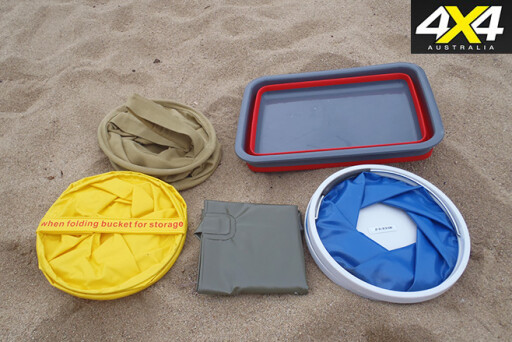
Far from being a luxury, a collapsible bucket is a must-have for any remote area traveller.
They’re easy to find room for when space is at a premium. They can fit into your toolbox, bug-out bag, fishing kit or back pack. Importantly, they’re also incredibly versatile. A collapsible bucket is an extremely utilitarian addition to your water system in an outdoor survival scenario. Here’s how they come in handy:
1. Collect Water. If you can fill a nine litre collapsible bucket with rain, river water or water from a hole in the ground, you’ve got enough H20 to satisfy an adult male for up to three days (depending on conditions). If you can’t get access to water so easily, stick the bucket under the edge of a tent, tarp, or any other water runoff.
 2. Bathe. Morale can be a big problem in an emergency situation. So too is a lack of hygiene. So, provided you’ve got a bit of water to spare, have a bird bath from your collapsible bucket.
2. Bathe. Morale can be a big problem in an emergency situation. So too is a lack of hygiene. So, provided you’ve got a bit of water to spare, have a bird bath from your collapsible bucket.
3. Laundry. Your clothes protect you from sunburn, dehydration, cold and insects. Maintaining the integrity of your clothing increases your chance of survival.
4. Food and bait. Whether you’re looking at berries, bait or the ‘catch of the day’, you’ll need somewhere to keep them.
5. Dousing fire. Having some extra water around in case your fire gets out of hand is always a good idea. The last thing you want in remote areas is to get caught up in a bushfire you’ve inadvertently started.
6. Filtration. If the only water you can access is contaminated by sediment – you’ll wish you had a collapsible bucket. If you’ve got a canvas version, you can use it as a filter for any water you collect.
If your bucket is made of reinforced PVC material, you can punch a hole in it, fill it with charcoal, gravel, sand and dry grass, and filter your water that way.
 You can also use spare clean clothing or coffee filters. Failing that, fill up your collapsible bucket, let the particulates settle and decant it off. Finally boil it before drinking.
You can also use spare clean clothing or coffee filters. Failing that, fill up your collapsible bucket, let the particulates settle and decant it off. Finally boil it before drinking.
7. Particulate separation. If you have a water filter with you, there’s no need to work it too hard. Instead of sticking it straight into a water source, use your collapsible bucket to skim water off the top without stirring up mud or silt. You can let any particulates settle back at camp and then run only the cleanest possible water through your filter to save wear.
8. Eliminate cross contamination. If you get stuck, you may find you only have a few water bottles available (if any). If you use your water bottle for collection, storage and drinking, obviously some of the contaminated water will be in your bottle. Why take the risk? Save your bottles for filtered and sterilised drinking water only. Use your collapsible bucket for the dirty work.
9. Yabbie Trap. Tie a small piece of meat to a rock. Place it in the bottom of your collapsible bucket then fill it with dry grass. Connect a rope or pole to the handle for retrieval and put it in the best spot in a water hole. Leave it for a few hours and, voila, lobster for dinner.
 10. Sea or sand anchor. If you’re lucky enough to have a boat, the last thing you want is to lose it. If your anchor has failed, your collapsible bucket can be used as a makeshift alternative. Fill it with rocks, attach a length of rope, and use it as a sand anchor.
10. Sea or sand anchor. If you’re lucky enough to have a boat, the last thing you want is to lose it. If your anchor has failed, your collapsible bucket can be used as a makeshift alternative. Fill it with rocks, attach a length of rope, and use it as a sand anchor.
Alternatively, throw it over the side empty and use it as a sea anchor. Once ashore, fill it with rocks and sand and it will help moor your vessel.

COMMENTS